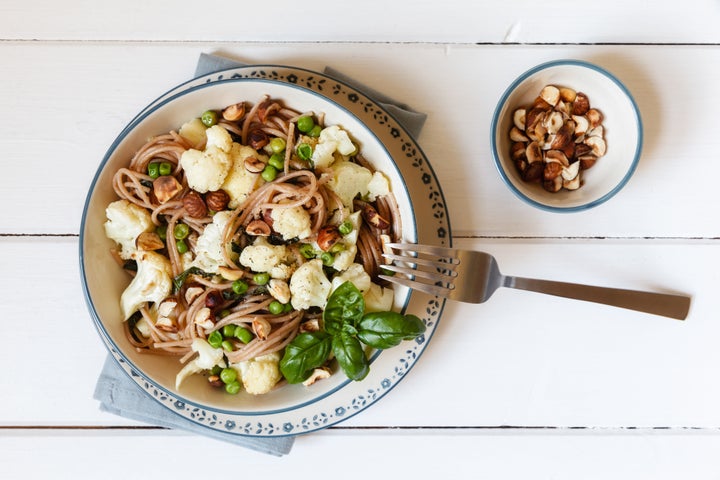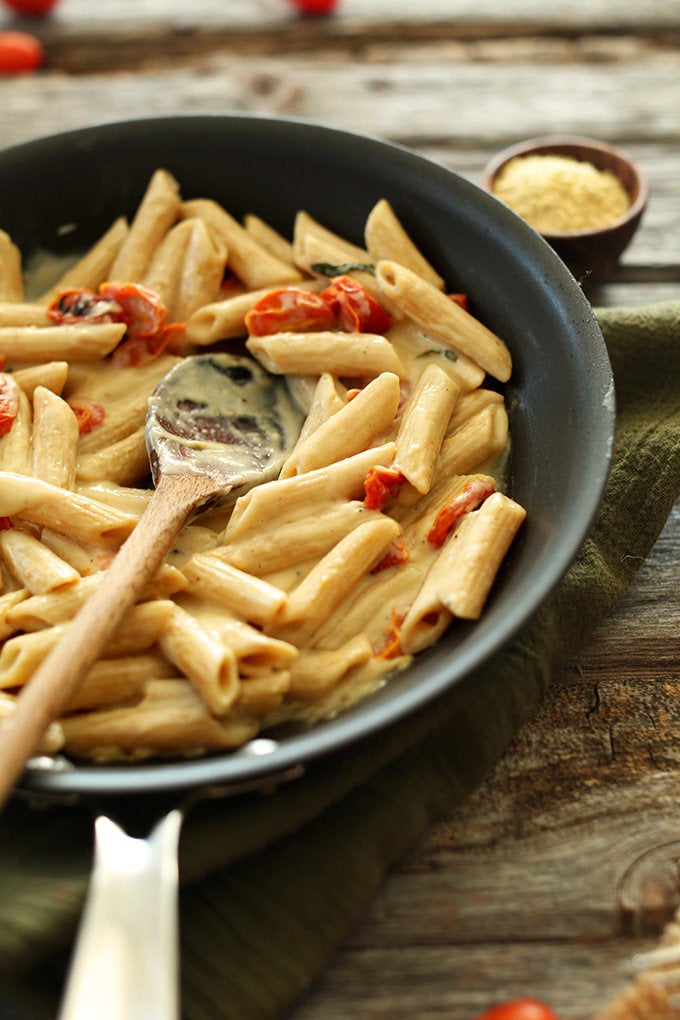
Pasta night is under fire. Whether you're following a low-carb, gluten-free, low-glycemic index or low-calorie diet, the pasta you know and love is probably on your do-not-eat list.
And without getting into the merits of every anti-white-pasta diet out there (which is basically every diet known to man), white pasta is a no-no for some pretty good reasons: During the milling process, white flour is stripped down to remove the grain’s bran and germ, and with them, fiber, protein, iron and B vitamins, explains Florida-based registered dietitian Jaime Mass.
What remains on your plate is a quick-acting carb, not altogether that different from pure sugar, spiking your blood sugar and resulting in an insulin rollercoaster that sets you up for cravings, weight gain and Type 2 diabetes, she says. And all waist measurements aside, research from the Harvard School of Public Health suggests that refined carbohydrates may be worse for your heart than saturated fat is. Meanwhile, a 2015 study in The American Journal of Clinical Nutrition found that people who eat refined grains face an increased risk of depression. So much for pasta’s comfort-food reputation.
Even those white pastas that are “enriched” with added fibers and vitamins generally have less of the good-for-you nutrients than do their whole counterparts. Plus, research from the University of Minnesota shows that, while fiber from whole sources is linked with a longer lifespan, fiber from refined grains isn’t.
Luckily, the more heat white pasta receives from critics, the more food manufacturers work to up their alternative-pasta game with whole grains, heart-healthy fiber, filling protein and more vitamins and minerals than you’ll find in a salad. (OK, that one really depends on the salad.) So, during your next trip down the pasta aisle, check out these six types of good-for-you grains. Just don’t forget to practice portion control. A serving size of pasta is still just half a cup.
1. Whole-Wheat Pasta
The traditional alternative to refined pasta, whole-wheat pasta is a great option for people who want to increase their fiber and protein intake, Mass says. Instead of being stripped down during the milling process, the flour in whole-wheat pasta is left whole, hence its name. Research published in The Journal of Nutrition has linked whole grains to a reduced risk of obesity, heart disease, Type 2 diabetes and some forms of cancer. However, it contains gluten, making it off-limits for those people with a gluten sensitivity or celiac disease, Mass says. Look for products that are 100 percent whole wheat. Many products say they are “made with whole wheat,” but contain primarily refined grains.
2. Quinoa Pasta
Quinoa is one amazing grain. (Well, technically, it’s a seed, but since it can be ground down into flour and used to make bread and pastas, most people count it as a grain.) In pasta form, quinoa flour contains more protein than any other flour you’ll find, is rich in iron and magnesium and is gluten-free, making it ideal for those with celiac disease, says registered dietitian Lori Zanini, a spokesperson for the Academy of Nutrition and Dietetics. Plus, according to research published in the European Journal of Nutrition, quinoa pasta reduces blood sugar, insulin and triglyceride levels better than other gluten-free pastas. However, a lot of food manufacturers have caught onto the quinoa hype, labeling boxes as quinoa pasta when the contents actually contain mostly rice or corn and just a little bit of quinoa, Mass says. Make sure your quinoa pasta is the real deal by reading the back. The list of ingredients should only contain one food: quinoa.
3. Buckwheat Noodles
Also known as soba noodles, buckwheat noodles are a type of Japanese pasta typically served cold. They're also lower in both calories and carbs than other pastas. “When compared to eating regular white pasta, switching to buckwheat noodles can cut your caloric intake in about half,” Mass says. However, make sure that “buckwheat” is the only ingredient and not a blend of multiple processed flours with some buckwheat thrown in there. As long as the pasta is 100 percent buckwheat and made in a facility that does not processes wheat, buckwheat noodles are actually both wheat and gluten free.
4. Sprouted-Grain Pasta
While the exact grains contained in any two brands of sprouted-grain pasta are going to be different, all sprouted-grain pastas contain grains that have germinated, split open and sprouted a little green shoot. Sprouted grains tend to have higher contents of B vitamins, protein and fiber, along with fewer grams of carbohydrates than their non-sprouted counterparts, Zanini says. That’s why they tend to have a lower impact on blood sugar levels than some other grains. For instance, in one Journal of Nutrition and Metabolism study, consumption of sprouted grains was linked with a lower blood sugar response and greater spike in satiety hormones than consuming white and whole grains that contained the same amount of carbs.
5. Spelt Pasta
Like quinoa, spelt is an “ancient grain,” meaning it has been around for thousands of years and changed very little, if at all, during that time. In your pasta bowl, spelt pasta is a high-fiber, high-protein option that’s free of wheat. But that doesn’t mean it’s free of gluten. “Spelt is a close cousin to wheat and does contain moderate amounts of gluten,” Mass says. For that reason, it’s not suitable for people with celiac disease. However, people with mild gluten intolerances can often eat it without gastrointestinal upset. Make sure your box says “whole grain spelt,” as some manufacturers also sell spelt that has been refined.
6. Brown Rice Pasta
While not necessarily any more nutritious than the other alternative pastas out there, brown rice pasta is an ideal way for people with severely restricted diets or food sensitivities to get their pasta on, Mass says. Brown rice pasta is free of both gluten and FODMAPs (fermentable oligosaccharides, disaccharides, monosaccharides and polyols), molecules that can be poorly absorbed in people with irritable bowel syndrome.
The Healthiest Pastas was originally published on U.S. News & World Report.
More from U.S. News:
What Not to Say When Someone Loses Major Weight
10 Healthy Meals You Can Make in 10 Minutes
The 10 Best Heart-Healthy Diets
Also on HuffPost:
